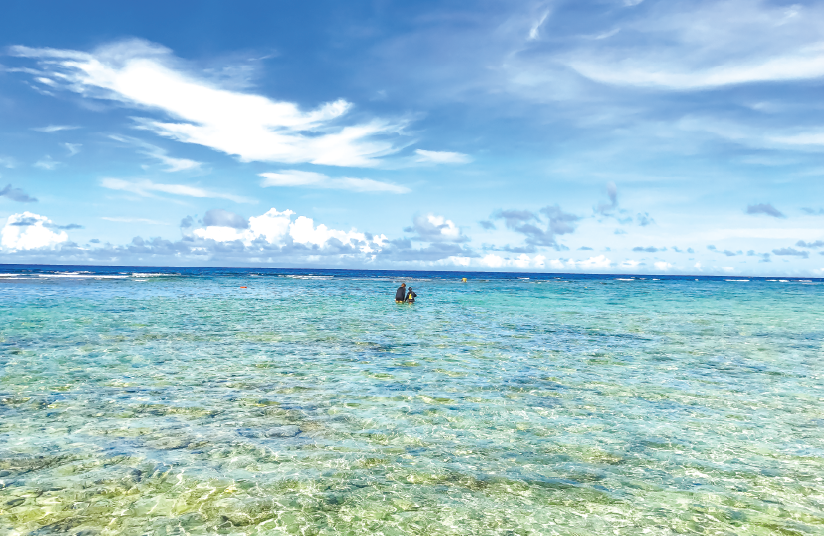
The prospect of an international locum tenens assignment can be both intimidating and exciting. Physicians interested in living as a locums in Guam will have a more immersive experience than you ever could as a tourist. Experience new foods, a tropical island location, and a unique culture, with many familiar things that will make life similar to living in the continental U.S.
Although Guam is a U.S. territory, it’s an island that’s 2,400 miles nearer to Japan than to the closest U.S. state, Hawaii. It’s also 1,200 times smaller than Texas. English is the official language, but Chamorro, the indigenous people group of the island is still widely spoken, making up about 40% of the population. Their unique culture makes an international assignment in Guam an exciting and unique adventure.

Establishing a home base as a locum tenens in Guam
Emergency and critical care medicine physician Dr. Bryan Zorko chose Guam as what he refers to as his first “big-boy job” after residency. He spent over a year on one of his assignments in Guam and had three shorter stints there, so he’s adept at becoming established and knows his way around Guam.
When Dr. Zorko first arrived in Guam, Global Medical Staffing provided his initial accommodations, but after a couple of weeks he decided to find his own housing.
“For my longer assignment, I got myself an apartment just by going through one of the local realtors,” he says. “It was a two-bedroom; a nice place. But don’t make the mistake I made and look on Craigslist for an apartment. Consider staying in a hotel for a little bit and then physically going into the apartments.”
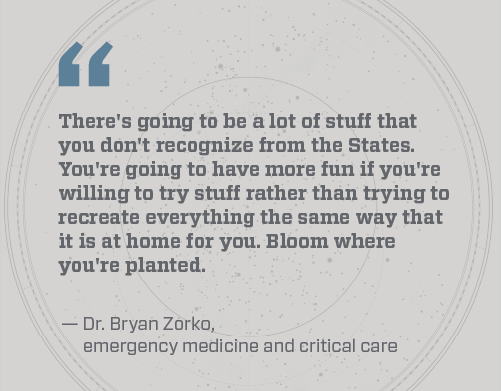
Dr. Zorko says when looking at housing, go in with an open mind. “There’s going to be a lot of stuff that you don’t recognize from the States. You’re going to have more fun if you’re willing to try stuff rather than trying to recreate everything the same way that it is at home for you. Bloom where you’re planted.”
Enjoy international locums but want to work closer to home? GMS can help with that too!
Unique challenges and rewards of practicing medicine in Guam
Dr. Zorko shared his unique experiences working in Guam, highlighting the diverse medical challenges and cultural encounters he faced. “Guam has a lot of interesting mixes of stuff that you may not see in the States, like we had a lot more tuberculosis than I was used to seeing,” he says. “There’s some infectious diseases like leptospirosis that I haven’t really seen before I came out here. You get taught about them, but you never have to really treat them.”
Dr. Sue Ming shared her unique experiences as a locum neurologist in Guam, highlighting the differences in her daily work compared to other medical professionals. She says, “As a neurologist, my daily work schedule may be a little bit different from the hospitalists or emergency room doctors. I would see more inpatients and emergency room patients, stay a little longer, and have to see these patients a few more times than I otherwise would.”
She says that there are challenges as well as rewards of working in Guam. “We had to do more psychological consulting and therapy, but the patients are very understandable. I see fewer unreasonable patients here than in my previous place. They’re really appreciative of the healthcare.” She found it a pleasure to work with the local population, especially the Chamorro people, who, despite often ignoring their health needs until they are very sick, are very down-to-earth and appreciative of the care they receive.
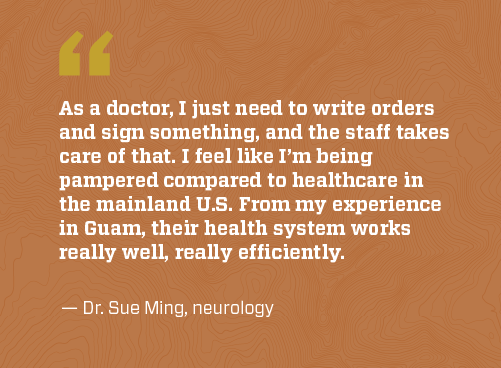
“As a doctor, I just need to write orders and sign something, and the staff takes care of that,” she says. “I feel like I’m being pampered compared to healthcare in the mainland U.S. From my experience in Guam, their health system works really well, really efficiently.”
Transportation on the island
Locum physicians can either rent or buy a car while on assignment in Guam, but buying can be an attractive option when assignments are longer term. Dr. Zorko decided to rent initially since he thought he’d be there for only three months. Eventually, he decided to buy a used car when he extended his assignments.
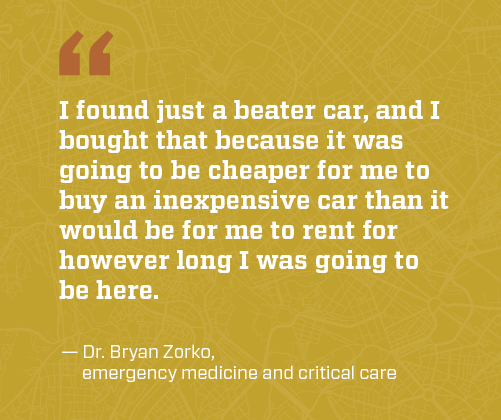
“I found just a beater car,” he says, “and I bought that because it was going to be cheaper for me to buy an inexpensive car than it would be for me to rent for however long I was going to be here.”
Guam also has public transportation that connects nearly all the villages on the island.
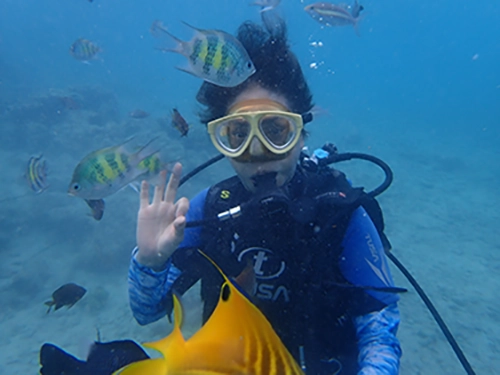
Recreation on Guam
Being in the middle of the North Pacific Ocean means tropical island weather — between 70 and 90 degrees year-round — and an abundance of outdoor recreational opportunities. Dr. Zorko got scuba certified while he was there on his first assignment.
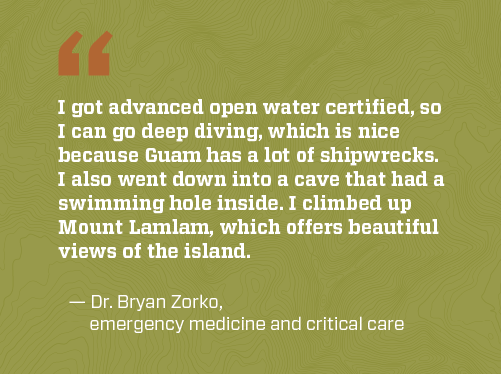
“I got advanced open-water certified so I can go deep diving which is nice because Guam has a lot of shipwrecks,” he says.
Dr. Zorko also enjoys hiking and running on the island, and says there are many hiking trails and small little beaches to explore. “I also went down into a cave that had a swimming hole inside. I climbed up Mount Lamlam, which offers beautiful views of the island.”

Dr. Ming also became scuba certified once she landed on the island, and just enjoyed the opportunity to live on a tropical paradise. “The color of the water looks like a postcard,” she says. “On the west side of the island the ocean is shallow; it’s really zero depth. The east side is a sheer drop. They’re both gorgeous. I keep driving around on weekends; I just drive, relax, and enjoy it. It’s truly paradise.”
Get a glimpse of the locum tenens experience in Guam:
Local cuisine
Dr. Zorko says you can find almost any American-style food or restaurant in Guam — from fast-food to mom-and-pop restaurants. ”I’d say it’s almost exactly like living in the States with a couple of exceptions,” he says. “There’s a lot more local influence on the food that’s available.”
And since Guam is such an isolated island, the average price of food is higher than stateside. Dr. Zorko says things like milk and cheese are more expensive, “but I don’t think there’s anything that I deeply miss at home that I can’t get on Guam if I’m willing to either wait a little bit for the shipment or pay a bit more.”
But one of Dr. Zorko’s and the locals’ favorites? Guam’s food trucks. They’re all over the island, and they offer just about any food that you could want, according to Dr. Zorko. And the local cuisine doesn’t disappoint.
“There’s a lot of grilled barbecue stuff,” he says. “But the things I probably eat the most is kelaguen. I also really enjoy banana spring rolls and Spam fried rice. And you can just pick it up and go to the beach to eat.”
Preparation is key for international assignments
Taking a locums assignment thousands of miles from home can be life-changing, but planning ahead will make the transition much smoother — and then you can spend your time having the experience of a lifetime, both personally and professionally.
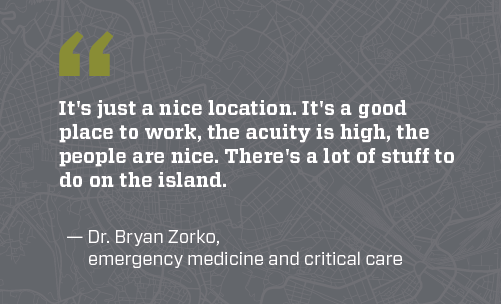
“It’s just a nice location,” Dr. Zorko says. “It’s a good place to work and the people are really nice and really open. It’s been a really nice opportunity.”
Are you ready to start your Guam adventure? Give us a call at 1.800.760.3174 or view today’s locum tenens job opportunities.



 Back
Back